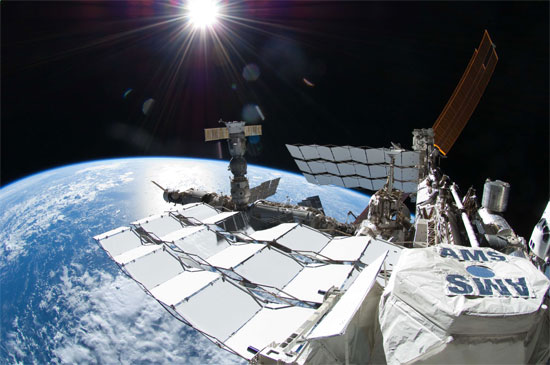Hypothesis of 'mirror world'
Scientists believe that the mysterious dark matter form that serves as the cosmic link is actually hiding another world, and that is the reflection of the world we are seeing.
>>>Found signs of dark matter
For a long time, researchers have failed to show that dark matter exists. Supposedly the building blocks for the universe, this mysterious material always escapes the eyes of observers of the scientific world. Despite the $ 2 billion device on the International Space Station (ISS), which is thought to have finally caught a glimpse of dark matter, this material has never been observed directly.

Spectrometer from Alpha, the hope of the world
expert in the journey to hunt dark matter - (Photo: NASA)
While the mystery is still unanswered, a new hypothesis is equally impressive. Accordingly, dark matter may be hiding 'a mirror world' , which might be enough to upset all previous human knowledge of the universe. New Scientist's website quoted expert James Bullock of the University of California at Irvine, observing that the existence of a mirror world, reflecting the image of the real world, will open up countless new things about outer space. Earth.
Earlier this month, a group of international experts announced the cosmic ray detector on ISS, called the spectrophotometer from Alpha (AMS), to find the first trace of dark matter. Judging by the findings, physicist at CERN, Pauline Gagnon, said the experiments could change people who see the universe, and allow us to 'catch ' dark matter early. 'That's great, like discovering a new continent. It will really open the gate to connect with a completely different world ' , according to Gagnon expert. Meanwhile, physicist Samuel Ting, owner of the Nobel Prize for Physics in 1976, is confident to predict that the scientific community will have a more concrete answer to dark matter within a few months.
Dark matter, thought to cover galaxies in the universe, is invisible because it does not reflect light. Experts have speculated about its existence thanks to the gravitational force acting on planets and stars. Last month, the Planck telescope of the European Space Agency (ESA) published data recorded shortly after the Big Bang event 13.8 billion years ago, showing a mysterious form of material created. 26.8% of the density of the universe, higher than previously anticipated. Normal matter, including galaxies and planets, accounts for only 4.9%. Scientists believe that identifying the structure of dark matter can open up new areas of research, without excluding the possibility that there are interconnected universes and other dimensions. .
- The invention of a mirror with a much wider viewing angle than a conventional mirror
- The bronze mirror is still shiny after 1,900 years underground
- Strange mysteries around the mirror
- The largest space mirror in the world
- Why do we find ourselves most beautiful in the mirror?
- The mirror of the
- Looking at mirrors can predict the disease
- Over the face of self-help, self-portrait was born
- The truth of 'making a haircut' about a mirror of 'life-threatening' 38 people
- Video: Smart mirror integrates computer screen
- How does the double-sided mirror in the interrogation rooms work?
- The special mirror turned sad face into joy
 Van Allen's belt and evidence that the Apollo 11 mission to the Moon was myth
Van Allen's belt and evidence that the Apollo 11 mission to the Moon was myth The levels of civilization in the universe (Kardashev scale)
The levels of civilization in the universe (Kardashev scale) Today Mars, the sun and the Earth are aligned
Today Mars, the sun and the Earth are aligned The Amazon owner announced a secret plan to build a space base for thousands of people
The Amazon owner announced a secret plan to build a space base for thousands of people